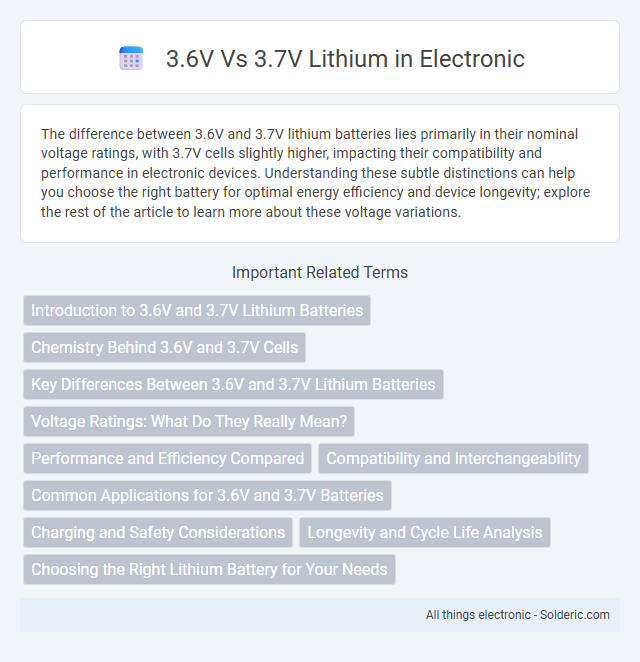The difference between 3.6V and 3.7V lithium batteries lies primarily in their nominal voltage ratings, with 3.7V cells slightly higher, impacting their compatibility and performance in electronic devices. Understanding these subtle distinctions can help you choose the right battery for optimal energy efficiency and device longevity; explore the rest of the article to learn more about these voltage variations.
Comparison Table
| Feature | 3.6V Lithium Battery | 3.7V Lithium Battery |
|---|---|---|
| Nominal Voltage | 3.6 Volts | 3.7 Volts |
| Chemistry | Lithium Iron Phosphate (LiFePO4) | Lithium Cobalt Oxide (LiCoO2) or Lithium-ion variants |
| Energy Density | Lower (~90-120 Wh/kg) | Higher (~150-200 Wh/kg) |
| Cycle Life | Longer (2000+ cycles) | Shorter (300-500 cycles) |
| Thermal Stability | High, safer under stress | Moderate, prone to overheating |
| Applications | Electric vehicles, power tools, energy storage | Consumer electronics, smartphones, laptops |
| Cost | Higher upfront cost | Lower upfront cost |
Introduction to 3.6V and 3.7V Lithium Batteries
3.6V and 3.7V lithium batteries are common nominal voltage ratings for lithium-ion and lithium polymer cells, reflecting slight variations in chemistry and design. The 3.6V rating typically corresponds to lithium cobalt oxide (LiCoO2) cells, while 3.7V is associated with lithium manganese oxide (LiMn2O4) and lithium nickel manganese cobalt oxide (NMC) chemistries. These nominal voltages impact battery performance characteristics such as energy density, discharge rates, and cycle life, making selection crucial for applications in portable electronics and electric vehicles.
Chemistry Behind 3.6V and 3.7V Cells
3.6V and 3.7V lithium cells primarily differ due to their cathode chemistry and voltage measurement standards; 3.6V cells typically use lithium cobalt oxide (LiCoO2), while 3.7V cells often employ lithium manganese oxide (LiMn2O4) or lithium iron phosphate (LiFePO4). The nominal voltage of 3.6V reflects the average operating voltage during discharge, whereas 3.7V corresponds to the peak voltage under full charge, influenced by the electrochemical properties of the cathode material. Understanding these distinctions allows you to select the appropriate cell type for optimized performance and battery life in your specific application.
Key Differences Between 3.6V and 3.7V Lithium Batteries
The key differences between 3.6V and 3.7V lithium batteries lie primarily in their nominal voltage ratings, which reflect the average operating voltage during discharge. A 3.6V lithium battery typically uses lithium iron phosphate (LiFePO4) chemistry, offering enhanced thermal stability and longer cycle life, while the 3.7V battery often references lithium cobalt oxide (LiCoO2) chemistry, known for higher energy density but reduced safety margins. Your choice depends on the specific application requirements for energy density, safety, and battery longevity.
Voltage Ratings: What Do They Really Mean?
Voltage ratings of 3.6V and 3.7V lithium batteries represent nominal voltages based on the average operating voltage during discharge cycles. These values reflect slight variations in lithium chemistry, where 3.6V cells often use lithium cobalt oxide (LiCoO2) and 3.7V cells correspond to lithium manganese or nickel-based chemistries. Understanding nominal voltage is crucial for device compatibility and battery management system calibration, ensuring optimal performance and safety standards.
Performance and Efficiency Compared
3.7V lithium-ion batteries typically offer slightly higher voltage, resulting in better energy density and improved performance in high-drain applications compared to 3.6V cells. The increased nominal voltage enables more efficient power delivery and longer battery life for devices such as smartphones and electric vehicles. Both voltages maintain similar chemical compositions, but the 3.7V cells optimize energy output, enhancing overall efficiency.
Compatibility and Interchangeability
3.6V and 3.7V lithium batteries are often interchangeable in devices designed for lithium-ion chemistry, as the voltage difference is minimal and typically within the acceptable range of voltage tolerance. Your device's charging circuits and protection modules usually accommodate both voltages without performance issues, ensuring compatibility across most applications. Always verify the device specifications to confirm that the slight variance does not impact safety or operational efficiency.
Common Applications for 3.6V and 3.7V Batteries
3.6V lithium batteries are commonly used in high-drain devices such as power tools and electric vehicles due to their stable voltage and high energy density. 3.7V lithium batteries, often found in consumer electronics like smartphones, laptops, and portable gadgets, offer slightly higher nominal voltage benefiting compact and lightweight designs. Your choice between these voltages should consider the specific power requirements and form factor of the application for optimal performance.
Charging and Safety Considerations
Charging 3.6V vs 3.7V lithium batteries requires attention to their nominal voltage differences, as using the correct charger voltage ensures optimal performance and battery longevity. Overcharging or applying higher voltage than specified can lead to swelling, overheating, or potential fire hazards, making adherence to manufacturer charging specifications critical for safety. Your charging equipment should match the battery's rated voltage and incorporate protection circuits to prevent overcharge and thermal runaway risks.
Longevity and Cycle Life Analysis
3.7V lithium-ion batteries typically have a nominal voltage of 3.6-3.7V, with minimal difference between the two labels, but the slight voltage variation affects longevity and cycle life. Your 3.6V batteries often use lithium cobalt oxide chemistry, offering stable cycle life with about 300-500 cycles, while 3.7V batteries may use improved chemistries like lithium manganese or lithium nickel, extending cycle life up to 1000 cycles or more. Optimizing your battery choice based on voltage rating can enhance device performance and lifespan due to differences in charge capacity and discharge stability.
Choosing the Right Lithium Battery for Your Needs
When choosing the right lithium battery for your needs, understanding the difference between 3.6V and 3.7V lithium batteries is crucial. Both voltages often refer to the nominal voltage of lithium-ion cells, where 3.6V cells are typically older or older-specification cells and 3.7V cells are slightly more common in modern batteries due to their higher nominal voltage providing marginally better energy density. Selecting the correct voltage depends on your device requirements and compatibility to ensure optimal performance and battery life.
3.6V vs 3.7V lithium Infographic

 solderic.com
solderic.com